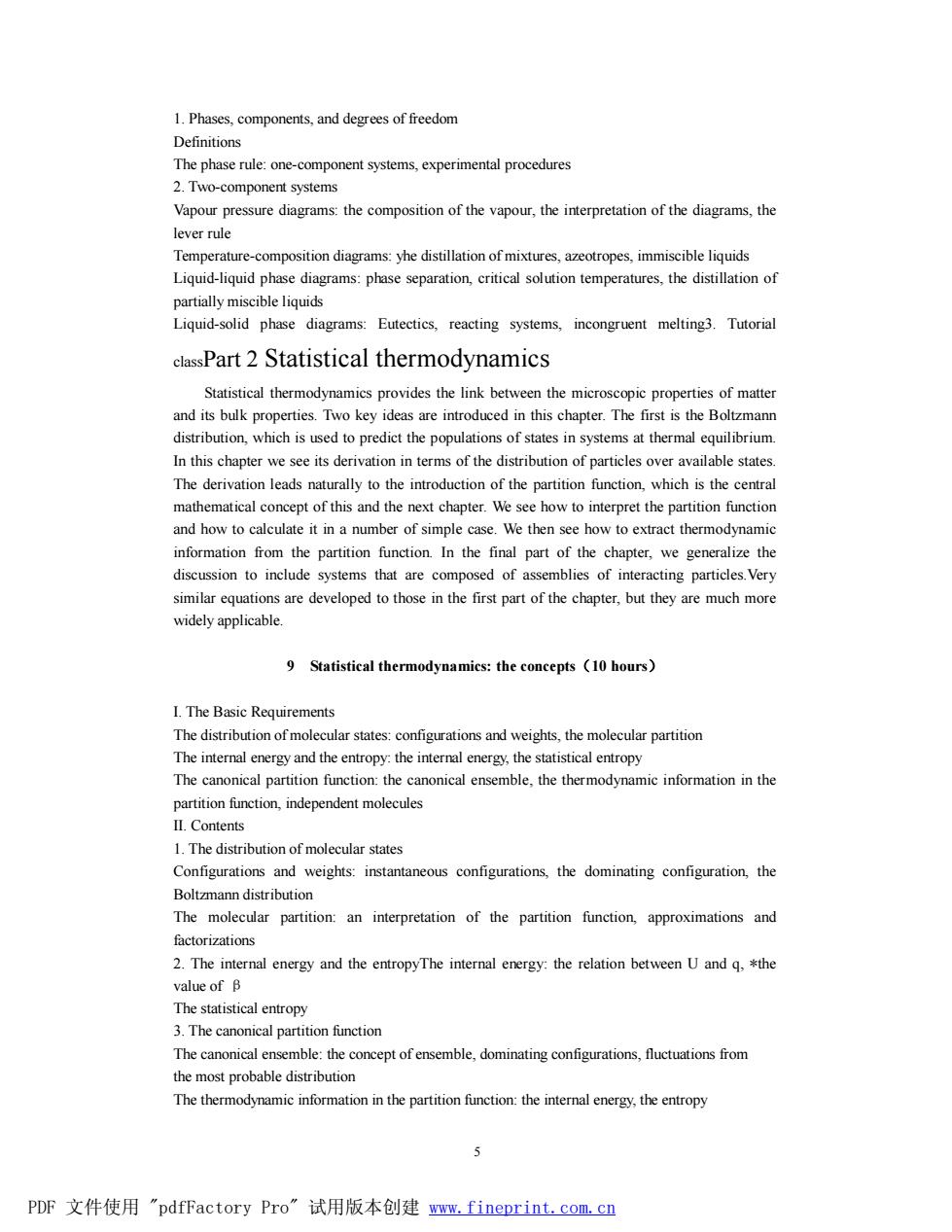正在加载图片...

1.Phases,components.and degrees of freedom Definitions The phase rule:one-component systems,experimental procedures 2.Two-component systems Vapour pressure diagrams:the composition of the vapour.the interpretation of the diagrams.the lever rule Liquid-liquid phase diagrams:phase separation,critical solution temperatures,the distillation of partially miscible liquids Liquid-solid phase diagrams:Eutectics,reacting systems,incongruent melting3.Tutorial elassPart 2 Statistical thermodynamics Statistical thermodynamics provides the link between the microscopic properties of matter and its bulk properties.Two key ideas are introduced in this chapter.The first is the Boltzmann distribution,which is used to predict the populations of states in systems at thermal equilibrium. In this chapter we see its derivation in terms of the distribution of particles over available states The erivation leads naturally to the introduction of the parttion which is the ce mathematical concept of this and the next chapter.We see how to interpret the partition fiuncti and how to calculate it in a number of simple case.We then see how to extract thermodynamic information from the partition function.In the final part of the chapter,we generalize the discussion to include systems that are composed of assemblies of interacting particles.Very similar equations are developed to those in the first part of the chapter,but they are much more widelyapplicable. 9 Statistical thermodynamics:the concepts (10 hours) I.The Basic Requirements he st The canonical partition function:the canonical ensemble,the thermodynamic information in the partition function,independent molecules IL Contents 1.The distribution of molecular states and weights: instantaneous configurations,the dominating configuration,the Boltzmann distribution The molecular partition:an interpretation of the partition function,approximations and factorizations 2.The internal energy and the entropyThe internal energy:the relation between U and q,*the value of B 3.The canonical partition function The canonical ensemble:the concept of ensemble.dominating configurations,fluctuations from the most probable distribution The thermodynamic information in the partition function:the internal energy,the entropy PDF文件使用"pdfFactory Pro”试用版本创建ww,fineprint.com,cn5 1. Phases, components, and degrees of freedom Definitions The phase rule: one-component systems, experimental procedures 2. Two-component systems Vapour pressure diagrams: the composition of the vapour, the interpretation of the diagrams, the lever rule Temperature-composition diagrams: yhe distillation of mixtures, azeotropes, immiscible liquids Liquid-liquid phase diagrams: phase separation, critical solution temperatures, the distillation of partially miscible liquids Liquid-solid phase diagrams: Eutectics, reacting systems, incongruent melting3. Tutorial classPart 2 Statistical thermodynamics Statistical thermodynamics provides the link between the microscopic properties of matter and its bulk properties. Two key ideas are introduced in this chapter. The first is the Boltzmann distribution, which is used to predict the populations of states in systems at thermal equilibrium. In this chapter we see its derivation in terms of the distribution of particles over available states. The derivation leads naturally to the introduction of the partition function, which is the central mathematical concept of this and the next chapter. We see how to interpret the partition function and how to calculate it in a number of simple case. We then see how to extract thermodynamic information from the partition function. In the final part of the chapter, we generalize the discussion to include systems that are composed of assemblies of interacting particles.Very similar equations are developed to those in the first part of the chapter, but they are much more widely applicable. 9 Statistical thermodynamics: the concepts(10 hours) I. The Basic Requirements The distribution of molecular states: configurations and weights, the molecular partition The internal energy and the entropy: the internal energy, the statistical entropy The canonical partition function: the canonical ensemble, the thermodynamic information in the partition function, independent molecules II. Contents 1. The distribution of molecular states Configurations and weights: instantaneous configurations, the dominating configuration, the Boltzmann distribution The molecular partition: an interpretation of the partition function, approximations and factorizations 2. The internal energy and the entropyThe internal energy: the relation between U and q, *the value of β The statistical entropy 3. The canonical partition function The canonical ensemble: the concept of ensemble, dominating configurations, fluctuations from the most probable distribution The thermodynamic information in the partition function: the internal energy, the entropy PDF 文件使用 "pdfFactory Pro" 试用版本创建 www.fineprint.com.cn